Swelling feet is one of the most prevalent conditions that is associated with pregnancy. Read on to find out the best compression socks to wear during pregnancy:
Why 20-30mmHG compression socks during pregnancy
When you’re pregnant, it’s normal for your body to undergo lots of changes. One of these is swelling. Naturally, pregnant women produce up to 50% more bodily fluids than other women. As such, it’s not a surprise to see their legs, face and hands swelling. This condition, commonly known as edema, affects most pregnant women.
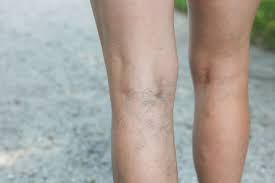
The good news is that there’s a tried and tested solution-compression socks. In the recent past, compression socks, or stockings are becoming a fad, thanks to their usefulness when it comes to dealing with swollen feet during pregnancy. Before we delve into the many benefits that compression stockings bring, let’s first understand why your feet swell during the maternity period.
First of all, when you’re pregnant, your body needs more fluids so it can relax and soften as it gets ready to develop and accommodate another little human being; your baby.
As a consequence, your body produces lots of progesterone during pregnancy. Dr. Iffath Hoskins of the University of New York says that excess progesterone leads to relaxed venous walls, which can easily pool blood into the lower body because of gravity.
While edema is the most common condition that’s associated with pregnancy, it’s not the only reason your feet swell in the maternity period. Other factors include; too much caffeine, too much salt in your food, walking or standing for long periods of time, or hot weather. Taking diets that lack enough potassium could also lead to swollen feet.
Swollen feet during pregnancy
Although some pregnant women have a swollen hands or face, most pregnant women have reported experiencing swollen feet. Swollen foot is not noticeable from day one of your pregnancy. In fact, it’s only noticeable after the fifth month, according to experts. While experts say that swollen feet during pregnancy is a normal occurrence, they advise pregnant women to seek immediate medical attention when they notice any excess swelling. In extreme cases, swelling can graduate into pre-enclampsia, another pregnancy condition characterized by sudden swelling.
Compression socks to the rescue
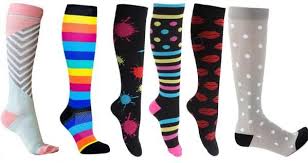
Compression socks are the go-to accessory when you’re pregnant, as they reduce swelling. They are designed in a way that they enhance smooth blood flow from the feet to the heart.
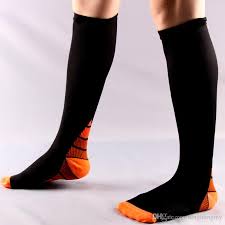
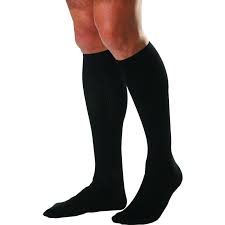
They not only enhance blood flow, but also reduce pain associated with swelling. Furthermore, they soothe varicose veins and prevent them from spreading. What’s more, they are comfortable to wear, and have few side effects that you can live with.
Before we look at how they work, it’s important to first understand what they are
Definition of compression socks
These are specialized socks, stockings or hosiery that are designed to enhance venous blood flow and to prevent venous disorders like edema and thrombosis from progressing.

They are made of elastic garment and are worn around the legs. Their purpose, like the name insinuates, is to compress the limbs. They do this by applying pressure to the lower legs. By so doing, their help you to maintain a smooth blood flow, while reducing discomfort and swelling.
How do they work?
Compression stockings, socks or hosiery exert pressure on your legs.

This pressure constricts the diameter of major veins, essentially increasing the velocity and volume of blood passing through the veins. Technically, this helps blood to flow toward the heart, reducing the chances of blood from backwards towards the legs or other superficial veins.
Different types of compression socks
When it comes to compression socks or sleeves, there’s no one size that fits all. They come in different sizes, lengths and compression.
Knee-length compression stockings

While most stockings are knee-length, some specialized ones are thigh-highs. Some have been fashioned into tights. All these serve the same purpose; they compress the limbs to enhance blood flow. Compression stockings can be worn off the bat without any prescription.
Prescription compression socks

However, for Deep Vein Thrombosis and other severe vascular diseases, patients are advised to seek a doctor’s prescription before donning any kind of compression stockings. Not getting a prescription can worsen things, that’s why it’s highly recommended especially when you’re pregnant.
Here are the three main types of compression stockings
Graduated compression socks
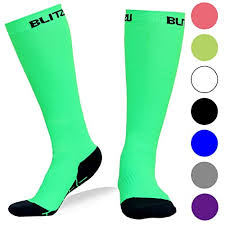
These apply more pressure around the ankle. This decreases as you head towards the top of the stockings. Given that they are designed to enhance mobility, these stockings have to meet certain specifications when it comes to strength and length. For this reason, a professional fitting is highly recommended.
Graduated stockings can vary in length. Most end just below the knee, while some can extend all the way to the waist, commonly known as waist-highs, or to the thighs(thigh-highs). It’s important to note that each length has its purpose. For instance, shorter stockings that terminate at the knee level are known to help with Edema, or buildup of fluid that causes swelling. Waist high or thigh high stockings help with orthostatic hypotension. They reduce chances of blood pooling in the legs.

With graduated compression stockings, there’s variety of colors to choose from. Some suppliers are also designing stockings with either an open or closed toe for use during pregnancy, so you can choose the maternity wear that you fancy.
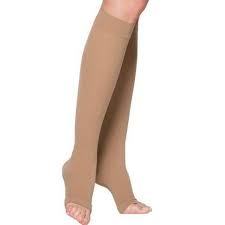
Anti-embolism socks
These are specifically designed to fight deep vein thrombosis. They also provide some level of graduated compression which is markedly different from that of graduated stockings. One difference that stands out between graduated and anti-embolism stockings is that the former are designed with mobility in mind while the latter are for those who are immobile.
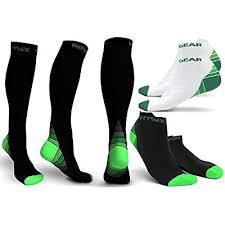
Nonmedical hosiery
Unlike graduated and anti-embolism stockings, these ones do not require any medical prescription. They are made of an elastic hose for support, and flight socks. Their main purpose is to relieve aching legs.
They have a uniform compression that exerts less pressure compared to prescription stockings. Because they are nonprescription, these stockings can easily be found in most pharmacies or online.

What about compression rating?
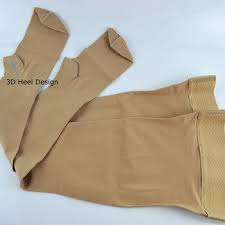
If you’re into prescription compression stockings, the compression level also matters. I fact, not getting a prescription could have adverse effects, as the socks could end up doing more harm than good. The kind of pressure that a doctor prescribes for you is what stands between you and your swollen legs.
That said, the right kind of pressure can fast track your recovery, while the wrong pressure level can worsen your condition. Compression in stockings is measured in millimeters of Mercury.(mmHG) In simple terms, this is the amount of pressure that the socks apply to your legs. When it comes to compression socks, the larger the compression number, the higher the pressure. A good example is the 20-30mmHG stockings, which deliver mild to medium pressure on your feet. 40-50mmHG compression stockings offer the highest compression, as their numbers indicate.
Common compression pressure ranges from 8mmHG to 50mmHG.
Compression levels and their application
8-15mmHG
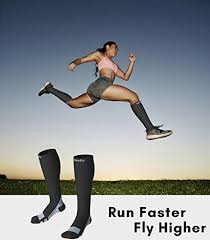
This compression stocking delivers the lowest form of pressure. It’s ideal for tired and aching legs. They gently enhance blood flow in the legs, combating minor venous swelling and giving your legs the energy they need, especially during pregnancy. They can also be used to manage swelling that is brought about by Diabetes.
15-20 mmHG
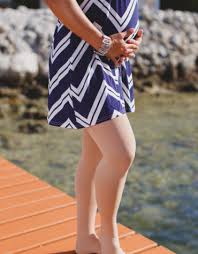
Like stockings with 8-15 mmHG of pressure, these stockings also deliver mild compression, great for relieving minor and moderate swelling, varicose veins and ache. They are good for anyone who sits or stands for long, especially expectant women. When travelling by air, they are an ideal item as they prevent deep vein thrombosis, a common condition for those travelling economy class due to the cramped spaces.
20-30mmHG
Of all the prescription compression stockings, the 20-30 mmHG is the most popular. It’s the most prescribed sock. It delivers moderate pressure and is useful when it comes to treating or managing mild conditions like edema, deep vein thrombosis, varicose veins, and post-schlerotherapy. In different circles, these stockings are commonly referred to as firm compression or class 1 stockings.

30-40mmHG
These are class 2 compression stockings that deliver moderate pressure to your legs. They are ideal for combating severe cases or edema, deep vein thrombosis and varicose veins. They are available as a prescription stocking and are also used to treat post-sclerotherapy. Given their high level of compression, they should be worn under the close supervision of a doctor.
40-50mmHG

With the highest level of compression, these are prescription –only stockings. They are categorized as class 3 compression stockings and are used to treat chronic cases of venous insufficiency. If you’ve been diagnosed with thrombotic syndrome, these stockings deliver the right level of compression to treat this condition.
What are the benefits of compression stockings?

Compression stockings have been found to deliver a wide range of benefits to those who wear them. Whether prescription or otherwise, they work magic on your swollen feet. Non-prescription stockings give your legs the energy boost that they need, while prescription socks do more.
For starters, they boost blood circulation in the legs, supporting your veins and preventing blood from pooling around your legs. As it is, blood that pools in the legs is bad news for you, especially if you’re pregnant. It causes your legs to swell, and this swelling can be accompanied by pain and discomfort. What’s more? Swollen legs can graduate into a more serious condition if it’s not monitored. These include; venous ulcers, deep vein thrombosis, orthostatic hypotension, varicose veins, and reverse hypertension of the veins.
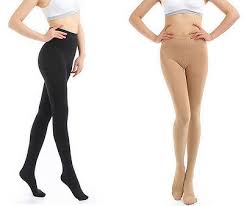
Side effects of compression socks
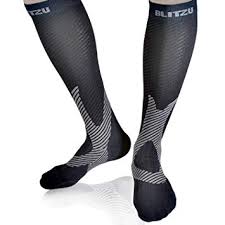
Like with anything that has benefits, compression hosiery has its share of side effects. According to Bill Meanwell from the International pedorthics School based in Oklahoma, compression stockings are ideal for anyone, expect those who have severe vascular disease. He says that the greatest risk is not to wear them and to end up with a blood clot.
Basically, you’re better off wearing compression stockings than not wearing them, according to Meanwell.
With that out of the way, compression stockings can lead to a number of skin conditions, including irritation and redness. If you have prescription stockings, it’s a good idea to keep on checking your feet for signs of redness and irritation.
The good news is that the side effects of compression stockings can be effectively dealt with.
Here are a few things that you should consider before settling on a pair of compression socks, either from a pharmacy or an online shop.
The fit
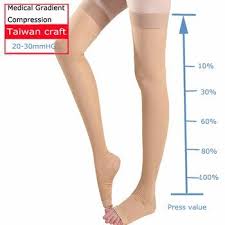
Make sure that your stockings are a good fit. If it’s too tight, it may worsen your condition. If it’s too loose, it’s ineffective and bothersome. The trick is to have your legs, ankle and thighs measured when ordering a pair of prescription socks.
Make sure you have no infections on your feet
This is a no brainer; infections won’t auger well with compression stockings because of the pressure involved. Most infections won’t do well with the moist environment that a compression stocking provides, so, it’s always a brilliant idea to avoid compression stockings when you have an infection. The same goes for those who are allergic to compression socks. In this case, it’s in your best interest to seek the counsel of a doctor.
Wear and remove prescription stockings properly
Believe it or not, how your put on prescription stockings matters a lot. In fact, a 2014 case report found that improperly worn stockings could easily hurt the skin. Another study conducted in the same year by the Canadian Medical association demonstrated that compression stockings could worsen ischemia for patients with an impaired arterial flow of blood.
In the same light, a 2007 found out that misused compression socks could lead to nerve damage. All this goes a long way to show the importance of proper use of compression stockings. Remember, some compression stockings can be worn with or without shoes.
Popular Articles on ComproGear
Best Compression Socks for Sitting All Day Stockings for Sitting During Long Drives
When to wear compression socks during pregnancy
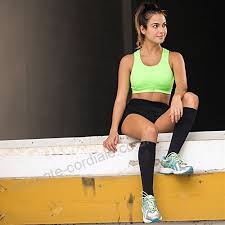
Experts recommend that you wear your compression socks at the start of the day when your legs haven’t started to swell. Once they swell, it becomes difficult for you to slip them into your feet. Dr. Hoskins says you should wear the socks whenever you anticipate that you’ll be walking, standing or sitting for long, or “whenever your feet are dangling,”
He adds that they shouldn’t be worn at night, as at that point, your body and limbs will be at the same level, so there’s not much gravity pull.
Best compression socks during pregnancy
If swollen feet is a problem during pregnancy, 20-30mmHG compression stockings are your friend. They come in different sizes, lengths, compression and colors, and you’ll be spoilt for choice when it comes to picking the ones that meet your needs. With maternity prescription compression socks, expect a smooth blood flow to the heart.
If you already have a prescription from your doctor, make sure you; get the right fit, follow all instructions on how to wear and remove them, and monitor any skin changes on your feet. Don’t watch helplessly as your legs swell. We have 20-30mmHG compression stockings that you can use during pregnancy. Alternatively, you can check out prices and order some from renowned online retailers on Amazon, or from many other online sellers.
This page last updated December 15, 2022
